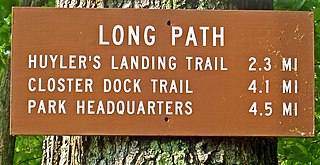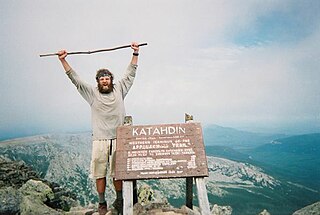Related Research Articles

The Appalachian Trail, also called the A.T., is a hiking trail in the Eastern United States, extending almost 2,200 miles (3,540 km) between Springer Mountain in Georgia and Mount Katahdin in Maine, and passing through 14 states. The Appalachian Trail Conservancy claims the Appalachian Trail to be the longest hiking-only trail in the world. More than three million people hike segments of the trail each year.

The Pacific Crest Trail (PCT), officially designated as the Pacific Crest National Scenic Trail, is a long-distance hiking and equestrian trail closely aligned with the highest portion of the Cascade and Sierra Nevada mountain ranges, which lie 100 to 150 miles east of the U.S. Pacific coast. The trail's southern terminus is next to the Mexico–United States border, just south of Campo, California, and its northern terminus is on the Canada–US border, upon which it continues unofficially to the Windy Joe Trail within Manning Park in British Columbia; it passes through the states of California, Oregon, and Washington.

The Continental Divide National Scenic Trail is a United States National Scenic Trail with a length measured by the Continental Divide Trail Coalition of 3,028 miles (4,873 km) between the U.S. border with Chihuahua, Mexico and the border with Alberta, Canada. Frequent route changes and a large number of alternate routes result in an actual hiking distance of 2,700 miles (4,300 km) to 3,150 miles (5,070 km). The CDT follows the Continental Divide of the Americas along the Rocky Mountains and traverses five U.S. states — Montana, Idaho, Wyoming, Colorado, and New Mexico. In Montana near the Canadian border the trail crosses Triple Divide Pass.

A Walk in the Woods: Rediscovering America on the Appalachian Trail is a 1998 travel book by the writer Bill Bryson, chronicling his attempt to thru-hike the Appalachian Trail during the spring and summer of 1996. For much of his journey, Bryson was accompanied by his friend Matt Angerer, who had previously appeared in Bryson's 1991 book Neither Here nor There: Travels in Europe.
Earl V. Shaffer, was an American outdoorsman and author known from 1948 as The Crazy One for attempting what became the first publicized claimed hiking trip in a single season over the entire length of the Appalachian Trail (AT). He also worked as a carpenter, a soldier specializing in radar and radio installation, and an antique dealer.

Emma Rowena (Caldwell) Gatewood, known as Grandma Gatewood,, was an American ultra-light hiking pioneer. After a difficult life as a farm wife, mother of eleven children, and survivor of domestic violence, she became famous as the first solo female thru-hiker of the 2,168-mile (3,489 km) Appalachian Trail (A.T.) in 1955 at the age of 67. She subsequently became the first person to hike the A.T. three times, after completing a second thru-hike two years later, followed by a section-hike in 1964. In the meantime, she hiked 2,000 miles (3,200 km) of the Oregon Trail in 1959. In her later years, she continued to travel and hike, and worked on a section of what would become the Buckeye Trail. The media coverage surrounding her feats was credited for generating interest in maintaining the A.T. and in hiking generally. Among many other honors, she was posthumously inducted into the Appalachian Trail Hall of Fame in 2012.

The Long Path is a 357-mile (575 km) long-distance hiking trail beginning in New York City, at the West 175th Street subway station near the George Washington Bridge and ending at Altamont, New York, in the Albany area. While not yet a continuous trail, relying on road walks in some areas, it nevertheless takes in many of the popular hiking attractions west of the Hudson River, such as the New Jersey Palisades, Harriman State Park, the Shawangunk Ridge and the Catskill Mountains. It offers hikers a diversity of environments to pass through, from suburbia and sea-level salt marshes along the Hudson to wilderness and boreal forest on Catskill summits 4,000 feet (1,220 m) in elevation.

Thru-hiking, or through-hiking, is the act of hiking an established long-distance trail end-to-end continuously.
The Appalachian National Scenic Trail spans 14 U.S. states over its roughly 2,200 miles (3,500 km): Georgia, North Carolina, Tennessee, Virginia, West Virginia, Maryland, Pennsylvania, New Jersey, New York, Connecticut, Massachusetts, Vermont, New Hampshire, and Maine. The southern end is at Springer Mountain, Georgia, and it follows the ridgeline of the Appalachian Mountains, crossing many of its highest peaks and running almost continuously through wilderness before reaching the northern end at Mount Katahdin, Maine.

Mount Oglethorpe is a mountain located in Pickens County, Georgia, United States. The southernmost peak in the Blue Ridge Mountains, the mountain has an elevation of 3,288 feet (1,002 m), making it the highest point in Pickens County, and the Atlanta Metropolitan Area.
The Great Eastern Trail is a network of hiking trails forming a long-distance route in the eastern United States. North of Georgia, the route runs parallel to, and slightly to the west of, the Appalachian Trail. As of 2022, it is still under development and its current length is approximately 1,600 miles (2,600 km). Upon its completion the network is projected to be more than 2,000 miles (3,200 km) in length.
Scott Williamson is an American thru-hiker, most noted for being the first person to complete a continuous one-season round trip of the Pacific Crest Trail (PCT). He is also noted for his speed records for hiking the PCT.

The Triple Crown of Hiking refers to the three major U.S. long-distance hiking trails:

Jennifer Pharr Davis is a long distance hiker from the United States of America who serves on the President's Council for Sports, Fitness, and Nutrition. She has been called "the Serena Williams of long distance hiking" by Baratunde Thurston and is also an author, speaker, National Geographic Adventurer of the Year, and Ambassador for the American Hiking Society. She has hiked over 14,000 miles on six different continents, including thru-hikes on the Pacific Crest Trail, the Appalachian Trail, the Colorado Trail, the Long Trail in Vermont, the Bibbulmun Track in Australia, and numerous trails in Europe and South America (e.g., the Tour du Mont Blanc, West Highland Way, Laugavegur, GR 11, GR 20, and the Pembrokeshire Coast Path, Cotahuasi Canyon and the Inca Trail.

The Appalachian Trail Museum is located in Pine Grove Furnace State Park near Gardners, Pennsylvania, United States, and commemorates the builders, maintainers and hikers of the Appalachian Trail, including those in the Appalachian Trail Hall of Fame. Features include a 1959 trail shelter from Peters Mountain built by Earl Shaffer, the first A.T. thru-hiker, vintage hiking and trail building equipment, historic A.T. signs, A.T. displays on permanent loan from the Smithsonian Institution, a recreation of A.T. founder Benton MacKaye's Sky Parlor office and a display on the National Trails System Act of 1968. The museum also has an extensive research library.

Francis Tapon is an author, global nomad, and public speaker. He has walked across the United States four times via its three major mountain ranges. He also walked across Spain twice. He was the first person to do a round-trip backpacking the Continental Divide Trail. In addition, he thru-hiked the Pacific Crest Trail and Appalachian Trail southbound. He has traveled to over 100 countries of the world. Lastly, he is the author of the self-help travelogue Hike Your Own Hike and the travel narrative The Hidden Europe: What Eastern Europeans Can Teach Us. He traveled to all 54 African countries from 2013 to 2018 and climbed to the highest point of 50 of those countries. In 2019, he was inducted into the California Outdoors Hall of Fame.
Edward B. Garvey thru-hiked the Appalachian Trail in 1970 and in 1971 published a book about his adventure, Appalachian Hiker, that raised awareness of thru-hiking.

North to Maine is a 2009 play by American playwright Brenton Lengel. It is the first play ever written about the Appalachian Trail and the thru-hikers who walk it. The play is sprawling and epic, with scenes taking place over the course of several months and many states, culminating with the ascent of Katahdin, the northern terminus of the Appalachian Trail.
Warren Doyle is a hiker and supporter of the Appalachian Trail. He holds the informal record for the hiking the entire Appalachian Trail the most times. From 1974 to 2017, he organized and led 10 groups up the entire Appalachian Trail. He is the founder of two organizations dedicated to the trail: the Appalachian Long Distance Hikers Association, and the Appalachian Trail Institute. He remains the Director of Appalachian Trail Institute.
Chester Dziengielewski, a machinist from Naugatuck, Connecticut, was the first person to successfully thru hike the Appalachian Trail from Maine to Georgia in 1951. Dziengielewski had attempted a southbound thru hike the previous year, but gave up the attempt at the Delaware Water Gap. He completed his hike on October 10, 1951, thereby becoming the third person to thru hike the Trail in any direction, after Earl Shaffer (1948) and Gene Espy (1951), who both hiked from Georgia to Maine.
References
- ↑ Grisamore, Ed (September 16, 2011). "Espy honored for famed Appalachian Trail hike". The Telegraph (Macon). Archived from the original on November 9, 2012. Retrieved June 9, 2012.
- 1 2 3 4 Pierce, John D. (May–June 2021). "The Curious Life of Gene Espy". Nurturing Faith Journal. 39 (3): 58–60.
- ↑ O'Brien, Bill (June 17, 2011). "A.T. Hall of Fame inducts its first class". Appalachian Trail Museum. Archived from the original on March 12, 2015. Retrieved June 9, 2012.